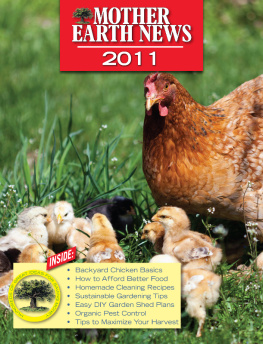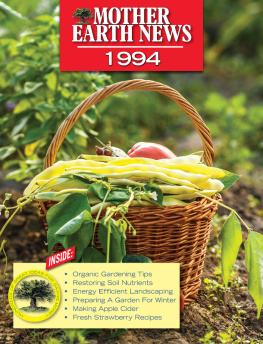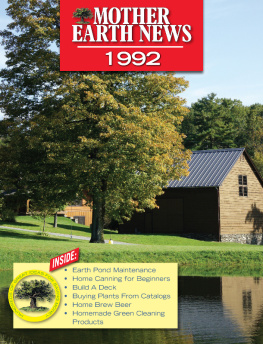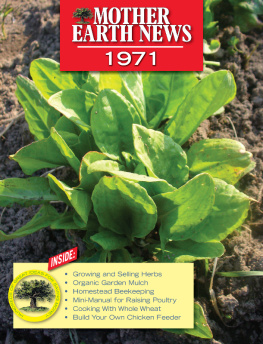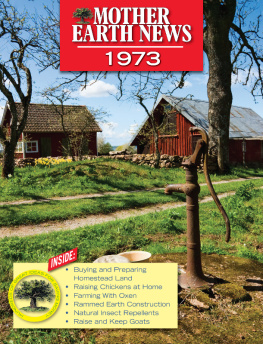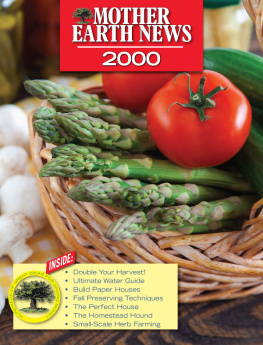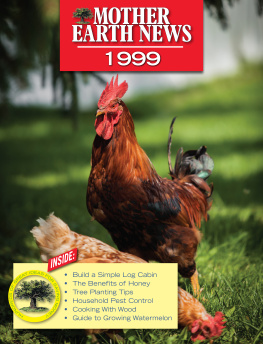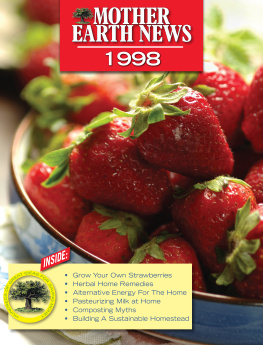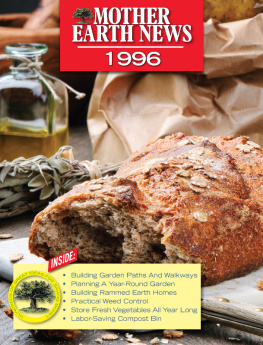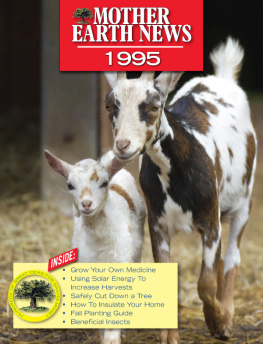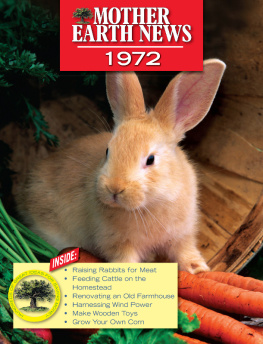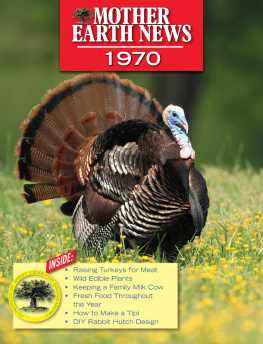Mother Earth News - Mother Earth News 1993
Here you can read online Mother Earth News - Mother Earth News 1993 full text of the book (entire story) in english for free. Download pdf and epub, get meaning, cover and reviews about this ebook. year: 1993, publisher: Mother Earth News, genre: Science / Home and family. Description of the work, (preface) as well as reviews are available. Best literature library LitArk.com created for fans of good reading and offers a wide selection of genres:
Romance novel
Science fiction
Adventure
Detective
Science
History
Home and family
Prose
Art
Politics
Computer
Non-fiction
Religion
Business
Children
Humor
Choose a favorite category and find really read worthwhile books. Enjoy immersion in the world of imagination, feel the emotions of the characters or learn something new for yourself, make an fascinating discovery.
- Book:Mother Earth News 1993
- Author:
- Publisher:Mother Earth News
- Genre:
- Year:1993
- Rating:3 / 5
- Favourites:Add to favourites
- Your mark:
- 60
- 1
- 2
- 3
- 4
- 5
Mother Earth News 1993: summary, description and annotation
We offer to read an annotation, description, summary or preface (depends on what the author of the book "Mother Earth News 1993" wrote himself). If you haven't found the necessary information about the book — write in the comments, we will try to find it.
Mother Earth News 1993 — read online for free the complete book (whole text) full work
Below is the text of the book, divided by pages. System saving the place of the last page read, allows you to conveniently read the book "Mother Earth News 1993" online for free, without having to search again every time where you left off. Put a bookmark, and you can go to the page where you finished reading at any time.
Font size:
Interval:
Bookmark:

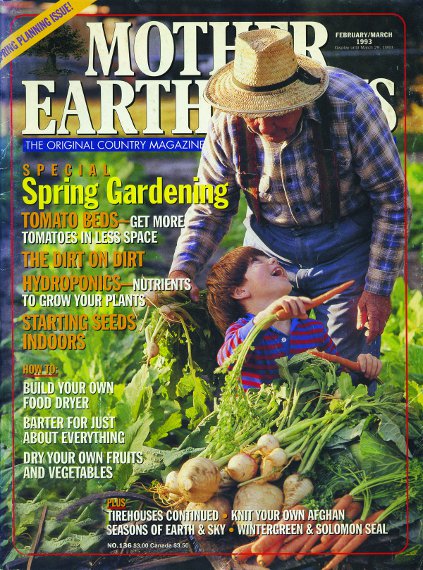
Readers tips on everything from deicing windshields, using eggshells in the garden, cleaning up oil spills with flour and more.
By the MOTHER EARTH NEWS editors
February/March 1993
Last winter, the bare path between our porch and gate became slippery from the packed snow. We sprinkled grass seed over the icy areas, which provided traction (and attracted birds as well). It did not harm the existing grass, as salt can, and when spring came, we were treated to a soft, green path where the bare dirt used to be.
-John and April Adkins
Charleston, West Virginia
For years I struggled with scraping the ice off my windshield during the winter. Last winter, I finally found the perfect solution: I purchased four pieces of scrap Plexiglas (approximately 10 x 24) from the local hardware store for about three dollars. I simply slip the Plexiglas on my windshield, and then pick them off in the morning for a perfectly clear windshield.
-Cecil Monk
Bangor, Michigan
Most of us drive around with a car jack stowed in the trunk. In the event of a flat tire, its indispensable. But a car jack has plenty of other useful applications too.
When I first moved to Vermont, I wanted to remove three large stumps from my backyard. As I tried to dig and chop roots in the rocky soil, I realized why the previous owner had left the stumps. About two-thirds of the way around the first stump, I encountered a large root that ran straight out from the stump, just below the surface. It looked like a wonderful lever to pry the thing out of the ground.
About seven feet from the stump, I dug under the root and cut through it. Then I cleared enough space out to slide my jack under the root. As I cranked the jack up, I heard popping noises as the old stump started to rise. When the jack reached full extension, I slid a cinder block under the root to hold it up. Then I lowered the jack and repositioned it. The second time, the stump came free, and I was convinced I was on to something.
The next two stumps proved to be more formidable. I replaced my scissors-type car jack with a 10-ton hydraulic jack. I was amazed that I could lift the roots right out of the ground, considering the huge size of them. Since then, I have used my hydraulic jack for many applications. Often a scissors jack works just as well, but I am reluctant to take it out of the trunk in case I forget to replace it and then have a blow out.
Recently I ran into a stubborn drainpipe connection under the kitchen sink. I sprayed it with bolt loosener and took a large pipe wrench to it, but it was in tight quarters and I couldnt exert much force on the wrench. There was enough room to slide my jack under the handle of the pipe wrench, and slowly crank it up. The connection broke loose with very little exertion on my part, and saved me the price of calling in a plumber.
-Mrs. C. Pruitt
Elkland, Missouri
Last year, I used my wood stove all winter long. When it came to cleaning it out after the last fire of the season, I poured in about an inch of kitty litter. This absorbs the musty odor throughout our humid summer, and is easy to clean out once winter rolls around.
-Janet CunninghamSouthern Pines, N. Carolina
Recently I broke a glass bottle filled with cooking oil on my kitchen floor. Of course, I was far more worried about the shards of glass then the big mess, but I came up with a simple idea solution. I sprinkled a little flour on the area, waited a few minutes, and then removed the oil and glass dough. It even cleaned the cracks between the tiles.
-David BlakeAlexandria, Indiana
To fertilize house plants, save four eggshells, crush them, and put them in a sealable jar with water. Let the shells sit for three days, and then water your house plants with them, so that just the top of the soil is wet. Water normally the next day. This mixture works well on outdoor plants also.
-Cynthia Haymon
Greenweal Springs, Louisiana
When I want to add eggshells to my compost, I rinse the empty shells and let them dry in a mesh onion bag. When the bag is full, I put it inside a paper bag and crush all the shells. (Small kids love this process!) The bits of shell can easily be mixed into your compost pile.
-Elimore Davis
St. Maries, Idaho
ILLUSTRATION: MOTHER EARTH NEWS STAFF
Kitty litter is very useful for absorbing musty smells.
Corn emits a chemical to attack predators, using peacocks as pets and pest control, and the problem with mining in residential areas.
By the MOTHER EARTH NEWS editors
February/March 1993
When caterpillars attack corn leaves, corn fights back. First a signal is emitted; then the corn kernels call in a troop of parasitic wasps to surprise attack the caterpillars. Female rescue wasps lay their eggs directly into the enemy caterpillars, and when they hatch, the larvae feast on the caterpillars insides. As the larvae mature, they crawl out of the caterpillars as wasps and fly away. Mission accomplished.
All right, you buy the part about the wasps, but what is this corn-signaling-for-help nonsense?
According to researchers Ted Turlings, Ph.D., and James Tumlinson, Ph.D., of the U.S. Department of Agriculture in Gainesville, Florida, corn emits a distress chemical, or turpenoid, when it senses caterpillar saliva. (Call it the spit factor.) Wasps then pick up the turpenoids scent and fly over to save the day.
The two researchers are currently trying to figure out why the corn reacts to the caterpillars saliva. They are also rearing wasps in the laboratory and teaching them to read the corns distress signal. Turlings and Tumlinson have developed a synthetic blend (similar to the turpenoid) that not only attracts wasps, but also poisons caterpillars and acts as an antibiotic against fungus and bacteria.
Turlings and Tulinson hope that one day farmers will sic em on cornfields by the swarm.
Peacocks arent just proud, they can be downright arrogant. Perhaps they have the regal appearance to pull it off, but nice garb shouldnt grant the right to cast looks.
So whod want one for a pet?
According to farmers Debra Buck and Dennis Fett, you might.
The married couple operates the largest peacock farm in the nation, selling over 1,000 peafowl-hatching eggs a year. They believe the peacock is the organic bug control of the 90s. Peafowl will eat the bugs eating your vegetables and the worms eating your apples. Theyre also easy to care for since they eat the same foods as most poultry (although they should also be given a game-bird food containing 30 percent protein).
If you can see it all now-beautiful lawn ornaments dining on unwanted pests hold up; there are still a few considerations you should mull over. For one thing, peafowl frequently snack on flowers and garden vegetables. Broccoli and cabbage seem to top their list. In fact, Buck and Fett suggest gardeners grow extra vegetables to compensate for the inevitable loss. Peafowl also have a rather strange cry that resembles the sound of someone screaming help! : This maybe somewhat disconcerting for you and your family, and down right traumatic for your neighbors.
Font size:
Interval:
Bookmark:
Similar books «Mother Earth News 1993»
Look at similar books to Mother Earth News 1993. We have selected literature similar in name and meaning in the hope of providing readers with more options to find new, interesting, not yet read works.
Discussion, reviews of the book Mother Earth News 1993 and just readers' own opinions. Leave your comments, write what you think about the work, its meaning or the main characters. Specify what exactly you liked and what you didn't like, and why you think so.


